In 1966, at a gathering of J.R.R. Tolkien fans in New York City, the poet W.H. Auden—once a student of the Professor’s at Oxford—famously stated: “Tolkien is fascinated with the whole Northern thing.” In describing Tolkien thus, Auden coined a phrase that encompassed more than mere geographical direction. It was, according to the late Steve Tompkins, himself a formidable essayist and scholar of Tolkien’s work, “the mythology, many-legended history, and darkness-defying worldview of the ancient Germanic and Norse peoples.” This dynamic was woven into the cultural DNA of the Professor’s beloved Anglo-Saxons, as well. All the peoples of the north held the same basic belief: that Fate was inexorable, that the good fight must be fought, and that victory—however glorious—was transient. In the end the monsters would win, and the long twilight of the north would give way to an eternal darkness where even the gods were doomed.
While Tolkien is arguably the most recognizable standard-bearer of “the Northern thing”, he was by no mean the first. Antiquarians and writers such as George Webbe Dasent, William Morris, H. Rider Haggard, and Arthur Gilchrist Brodeur poured forth thunderous tales of naked will and courage unfolding in the shadows of a pre-ordained ending of the world. And readers in the 19th and early 20th centuries lapped it up. Since then, whole generations of writers have turned their eyes in Auden’s so-called “sacred direction”, seeking inspiration for their own fiction in the tales and myths of pre-Christian Scandinavia. Myself included. Below, I give you five such books—not necessarily the most popular or the best-of-the-best, but five books which nonetheless embody the whole Northern thing, with its clash of iron and its grim determination that while an enemy might ultimately win the day, he won’t win this day.
Hrolf Kraki’s Saga by Poul Anderson
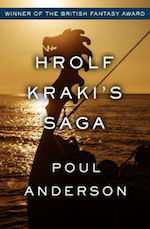 In the great tapestry of northern legend, the name Hrolf Kraki is woven throughout in glittering silver thread. We know of him from such diverse sources as Saxo Grammaticus’s Gesta Danorum; from the sagas of the Skjöldunga and the Ynglinga; from the Skáldskaparmál of the Norse; from the Anglo-Saxon Beowulf, and especially from the eponymous Icelandic tale, Hrólfs saga kraka. What Poul Anderson has done, though, is to take this remote figure of Arthurian proportions and render him in flesh and blood for the modern reader, giving context to the sometimes inexplicable motives and feelings of the ancient Scandinavians. Hrolf Kraki’s Saga is a grim and magnificent tale, filled with betrayal and murder, sibling rivalry and incest, and enough ax-play to sate a berserker.
In the great tapestry of northern legend, the name Hrolf Kraki is woven throughout in glittering silver thread. We know of him from such diverse sources as Saxo Grammaticus’s Gesta Danorum; from the sagas of the Skjöldunga and the Ynglinga; from the Skáldskaparmál of the Norse; from the Anglo-Saxon Beowulf, and especially from the eponymous Icelandic tale, Hrólfs saga kraka. What Poul Anderson has done, though, is to take this remote figure of Arthurian proportions and render him in flesh and blood for the modern reader, giving context to the sometimes inexplicable motives and feelings of the ancient Scandinavians. Hrolf Kraki’s Saga is a grim and magnificent tale, filled with betrayal and murder, sibling rivalry and incest, and enough ax-play to sate a berserker.
Swords of the North by Robert E. Howard (Rusty Burke, ed.)
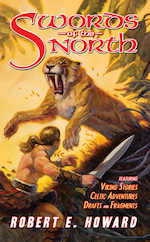 Of all the writers on this list, only Robert E. Howard had a view of the world not dissimilar from the grim ideals of the North. Indeed, it colors his work, from his first published story, “Spear and Fang” in 1924, to the last tale of that indomitable barbarian, Conan of Cimmeria, written before Howard’s death in 1936. Without exception, his characters—though lusty and larger than life—fight against “the iron collar of Fate” to make their mark upon the world before “sinking into final defeat with the froth of a curse on his lips.” This hefty 540-page volume, though rare, collects the finest examples of Howard’s prose and verse exemplifying the Northern thing. My own favorites include “The Grey God Passes,” about the Battle of Clontarf, and the brief but haunting “Delenda Est”.
Of all the writers on this list, only Robert E. Howard had a view of the world not dissimilar from the grim ideals of the North. Indeed, it colors his work, from his first published story, “Spear and Fang” in 1924, to the last tale of that indomitable barbarian, Conan of Cimmeria, written before Howard’s death in 1936. Without exception, his characters—though lusty and larger than life—fight against “the iron collar of Fate” to make their mark upon the world before “sinking into final defeat with the froth of a curse on his lips.” This hefty 540-page volume, though rare, collects the finest examples of Howard’s prose and verse exemplifying the Northern thing. My own favorites include “The Grey God Passes,” about the Battle of Clontarf, and the brief but haunting “Delenda Est”.
Eaters of the Dead by Michael Crichton
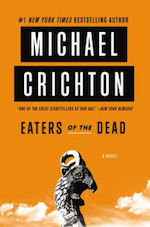 Though perhaps best known as the author of the wildly popular techno-thriller Jurassic Park, in 1976 Michael Crichton explored the Northern thing with Eaters of the Dead: The Manuscript of Ibn Fadlan Relating His Experiences with the Northmen in AD 922. Utilizing as his starting point the actual 10th-century manuscript of Ahmad Ibn Fadlan—who was an emissary from the Caliph of Baghdad to the king of the Volga Bulgars—Crichton skillfully builds a unique tale that mirrors the epic Beowulf. The tale veers from the historical when Ibn Fadlan is taken North against his will by a band of Vikings, led by the mighty Buliwyf, to combat a creeping terror that slaughters their people in the night. Along the way, the reluctant hero bears witness to the curious customs of the Northlands, from ship burials and human sacrifice to single combat and the fatalistic philosophy of the Viking.
Though perhaps best known as the author of the wildly popular techno-thriller Jurassic Park, in 1976 Michael Crichton explored the Northern thing with Eaters of the Dead: The Manuscript of Ibn Fadlan Relating His Experiences with the Northmen in AD 922. Utilizing as his starting point the actual 10th-century manuscript of Ahmad Ibn Fadlan—who was an emissary from the Caliph of Baghdad to the king of the Volga Bulgars—Crichton skillfully builds a unique tale that mirrors the epic Beowulf. The tale veers from the historical when Ibn Fadlan is taken North against his will by a band of Vikings, led by the mighty Buliwyf, to combat a creeping terror that slaughters their people in the night. Along the way, the reluctant hero bears witness to the curious customs of the Northlands, from ship burials and human sacrifice to single combat and the fatalistic philosophy of the Viking.
The Last Kingdom by Bernard Cornwell
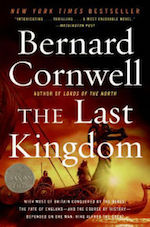 Bernard Cornwell’s is a familiar name to fans of historical fiction; he is the reigning king of the bloody and thunderous epic, with tales running the gamut—from the Stone Age through to the Napoleonic Wars. But with The Last Kingdom, set in a 9th-century England wracked by war, Cornwell really hits his stride. It is the tale of Uhtred son of Uhtred, a dispossessed earl of Northumbria, who is captured as a child and raised by pagan Danes. Uhtred is a Viking in all but blood, as swaggering and headstrong and profane as his foster-brother, Ragnar Ragnarsson—and every inch as dangerous in that crucible of slaughter, the shieldwall. Historical fiction is close cousin to fantasy, and Cornwell blurs the edges between the two by having characters who believe in the myths of the North, in the power of prophecy and magic. This clash of cultures, and of faiths, comes to a head when Uhtred is forced to choose: live as a Dane and become the enemy of God and King Alfred of Wessex, or return to the Saxon fold, pledge himself to Alfred, and perhaps win back his stolen patrimony: the Northumbrian fortress of Bebbanburg.
Bernard Cornwell’s is a familiar name to fans of historical fiction; he is the reigning king of the bloody and thunderous epic, with tales running the gamut—from the Stone Age through to the Napoleonic Wars. But with The Last Kingdom, set in a 9th-century England wracked by war, Cornwell really hits his stride. It is the tale of Uhtred son of Uhtred, a dispossessed earl of Northumbria, who is captured as a child and raised by pagan Danes. Uhtred is a Viking in all but blood, as swaggering and headstrong and profane as his foster-brother, Ragnar Ragnarsson—and every inch as dangerous in that crucible of slaughter, the shieldwall. Historical fiction is close cousin to fantasy, and Cornwell blurs the edges between the two by having characters who believe in the myths of the North, in the power of prophecy and magic. This clash of cultures, and of faiths, comes to a head when Uhtred is forced to choose: live as a Dane and become the enemy of God and King Alfred of Wessex, or return to the Saxon fold, pledge himself to Alfred, and perhaps win back his stolen patrimony: the Northumbrian fortress of Bebbanburg.
Blood Eye by Giles Kristian
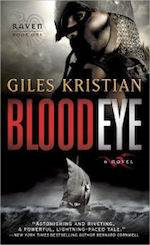 Reminiscent of Cornwell’s Uhtred, Osric—the hero of Giles Kristian’s Viking tale—is a young orphan who has no memory of his past. A deformed eye the color of blood marks him as a pariah among the villagers of Abbotsend on the coast of southern England, where he has spent his youth apprenticed to a mute carpenter. Such is the same small and lackluster life he expects to lead … until Norse raiders come to Abbotsend. Kristian’s Vikings, led by Jarl Sigurd the Lucky, are wondrous to behold: true sons of the North drawn in the vivid colors of their age; bold and fearsome and raucous men who want nothing more than wealth, wine, and women—men who seek Odin’s weather and a glorious death, sword in hand. The Norse spare Osric, who becomes one of them: a hard-as-nails reaver, a killer of men, touched by the Allfather; Sigurd names him Raven, and like a pack of wolves they fare forth in search of fortune or a storied death.
Reminiscent of Cornwell’s Uhtred, Osric—the hero of Giles Kristian’s Viking tale—is a young orphan who has no memory of his past. A deformed eye the color of blood marks him as a pariah among the villagers of Abbotsend on the coast of southern England, where he has spent his youth apprenticed to a mute carpenter. Such is the same small and lackluster life he expects to lead … until Norse raiders come to Abbotsend. Kristian’s Vikings, led by Jarl Sigurd the Lucky, are wondrous to behold: true sons of the North drawn in the vivid colors of their age; bold and fearsome and raucous men who want nothing more than wealth, wine, and women—men who seek Odin’s weather and a glorious death, sword in hand. The Norse spare Osric, who becomes one of them: a hard-as-nails reaver, a killer of men, touched by the Allfather; Sigurd names him Raven, and like a pack of wolves they fare forth in search of fortune or a storied death.
Top image from The Hobbit: The Battle of the Five Armies (2014)
 Scott Oden was born in Indiana, but has spent most of his life shuffling between his home in rural North Alabama, a Hobbit hole in Middle-earth, and some sketchy tavern in the Hyborian Age. He is an avid reader of fantasy and ancient history, a collector of swords, and a player of tabletop role-playing games. He is the author of A Gathering of Ravens, available from Thomas Dunne Books/St. Martin’s Press), a novel that pairs the “whole Northern thing” with a lifelong love of Orcs. His previous books include The Lion of Cairo, Memnon, and Men of Bronze.
Scott Oden was born in Indiana, but has spent most of his life shuffling between his home in rural North Alabama, a Hobbit hole in Middle-earth, and some sketchy tavern in the Hyborian Age. He is an avid reader of fantasy and ancient history, a collector of swords, and a player of tabletop role-playing games. He is the author of A Gathering of Ravens, available from Thomas Dunne Books/St. Martin’s Press), a novel that pairs the “whole Northern thing” with a lifelong love of Orcs. His previous books include The Lion of Cairo, Memnon, and Men of Bronze.









